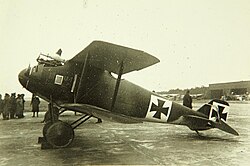Roland DI
| LFG Roland DI "Haifisch" | |
|---|---|

|
|
| Type: | Fighter plane |
| Design country: | |
| Manufacturer: |
Luftfahrzeug-Gesellschaft mbH (Roland) in Charlottenburg |
| First flight: |
July 1916 |
| Commissioning: |
1916-1917 |
| Production time: |
Autumn 1916 |
| Number of pieces: |
50-60 |
The Roland DI was the first of a series of three very similar fighters (Roland DI, D.II and D.III), which were developed by the engineers Tantzen and Hoffmann of the Luftfahrzeug-Gesellschaft mbH (Roland) in the city of Charlottenburg . Because of their aerodynamic shape, these fighter planes were given the name Haifisch .
Development and production
The design of the Roland DI was derived from that of the larger two-seater Roland C.II "Walfisch": Like the C.II, it had a hull in a wraparound design, which consisted of thin pine veneer strips glued across one another. The side coolers were attached to this very stable fuselage, and the upper wing was placed on a hump-like bulge. Similar to the “whale”, this meant an excellent upward view for the pilot, but the forward and downward view, which is particularly important for the pilot during landing, was blocked. A side window should enable the pilot to escape after a rollover; this was omitted from the later series models. Instead of the sturdy cross brace that connected the double-decker wings of the C.II, which were staggered towards the front, the wings on the "Haifisch", which were positioned vertically one above the other, were replaced by a conventional brace pair.
The first flight of the Roland DI took place in July 1916. At this point in time, the Air Force Inspectorate was urgently looking for a successor to the outdated Fokker monoplane and placed Roland with an initial order; about 50-60 aircraft were delivered, after which production at LFG was stopped because the production plant in Adlershof had been destroyed by fire.
After resuming production, Roland produced the more heavily armed Roland D.II together with the Pfalz-Flugzeugwerke, which in the meantime was licensed manufacturer .
commitment
The few Roland DI, which were clearly inferior to the competing models on the Western Front , were mainly used on the Macedonia Front in the Balkans by Bulgarian and German air units.
Technical specifications
| Parameter | Data |
|---|---|
| crew | 1 |
| length | 6.39 m |
| span | 8.9 m |
| height | 2.9 m |
| Wing area | 23 m² |
| Empty mass | 699 kg |
| Takeoff mass | 932 kg |
| Engine | a water-cooled six - cylinder in - line engine Mercedes D III with 160 PS (118 kW) |
| Top speed | 165 km / h |
| Rise time | at 4000 m: 24:24 min |
| Service ceiling | 5000 m |
| Armament | a 08/15 lMG |
- The Roland DI in a performance comparison (around the end of 1916)
| Surname | Motor power | Max. speed | Takeoff mass | MG | Summit height |
|---|---|---|---|---|---|
| Roland DI | 160 hp | 165 km / h | 932 kg | 1 | 5000 m |
| Sopwith Pup | 100 hp | 171 km / h | 556 kg | 1 | 5600 m |
| Nieuport 17 | 110 hp | 164 km / h | 560 kg | 1 | 5350 m |
| Albatros D.II | 160 hp | 175 km / h | 888 kg | 2 | 6000 m |
See also
literature
- Peter L. Gray, Owen Thetford: German Aircraft of the First World War . Putnam, London 1962, (3rd Edition, reprinted: ibid 1987, ISBN 0-85177-809-7 ).
- Peter M Grosz: LFG Roland D.II. Albatros Productions Ltd., Hertfordshire 1994, ISBN 0-948414-62-6 , ( Windsock Datafile 47).
- Günter Kroschel, Helmut Stützer: The German military aircraft 1910–1918 . Lohse-Eissing, Wilhelmshaven 1977, ISBN 3-920602-18-8 .
- Kenneth Munson - Combat Airplanes 1914–1919 Orell Füssli Verlag, Zurich 1968, p. 116
Web links
- Photo and individual representation (Russian) accessed on February 16, 2013
- Roland DI at PICSEARCH accessed on February 16, 2013
Individual evidence
- ↑ a b cf. Günter Kroschel, Helmut Stützer: The German military aircraft 1910–1918 . Lohse-Eissing, Wilhelmshaven 1977, ISBN 3-920602-18-8 , p. 139
- ↑ LFG Roland DI In: airwar.ru. Retrieved July 26, 2016 (Russian).